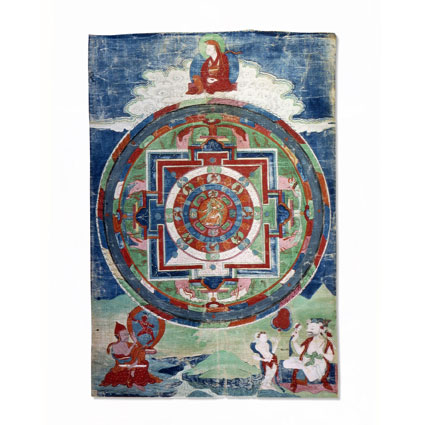ABP 025
Code: ABP 025
Country: Tibet
Style:
Date: 1700 - 1800
Dimensions in cm WxHxD: 25 x 37
Materials: Gouache on cotton
(From Wikipedia, the free encyclopedia)
Cakrasaṃvara Tibetan: Korlo Demchog (Wylie: khor lo sdom pa / bde mchog) is the principal yidam, or meditational deity, and herukaof the Kagyu sect of Tibetan Buddhism. The Cakrasamvara sadhana is considered to be of the mother class of the Anuttara Yoga Tantra. Cakrasamvara is typically depicted with a blue-coloured body, four faces, and twelve arms, and embracing his consort Vajravarahi in the yab-yumposition. Other forms of the deity are also known, with varying numbers of limbs. Cakrasamvara and consort are not to be thought of as two different entities, as an ordinary husband and wife are two different people; in reality, their divine embrace is a metaphor for the union of great bliss and emptiness, which are one and the same essence.
Vajrayogini or Vajravarahi
Vajrayogini or Vajravarahi (Tibetan: Dorje Naljorma, English: the Vajra yogini; also Tibetan: Dorje Phagmo, Wylie: rdo-rje phag-mo, English: the Vajra Sow) is a dakini, a tantric Buddhist ishta-deva(Tib. yidam). Her sadhana(practice) originated in India between the 10th and 12th century. It evolved from the Chakrasamvara sadhana, where Vajrayogini appears as his yab-yumconsort, to become a stand-alone practice in its own right.
Vajrayogini is often associated with triumph over ignorance as well as with abandonment (one of her hidden aspects is Varuni, Hindu goddess of alcohol and intoxication). Vajrayogini is key to the advanced sadhanaof Chöd. Vajrayogini is visualized as the translucent, deep red form of a 16 years old female with the third eye of wisdom set vertically on her forehead. Iconographically, Vajrayogini, like most of the Dakini, is often signified with the investiture of Digambar. She is often pictured with a sow and is an important deity for tantric initiation, especially for new initiates - Vajrayogini's practice is said to be well-suited to those with strong desirous attachment, and to those living in the current "degenerate age". Her consort is Chakrasamvara, who is often depicted as a spear on Vajrayogini's shoulder. The seven-headed form of Vajrayogini is similar to the Hindu goddess Chinnamasta. Vajrayogini is the yidamthat a meditator identifies with when practicing Six yogas of Naropa
In Tibet the abbess of Samding monastery, on the shores of the Yamdrok Tso Lake near Gyantse, was traditionally a tulkuof Dorje Phagmo. The current incarnation resides in Lhasa.
Bhattacharyya, Benoytosh , 1958. Indian Buddhist Iconography. Calcutta: K. L. Mukhopadhyay. Pp. 159.165 - References to Cakrasamvara, Mahamaya, Samvara, and Vajradaka
Chandra, Lokesh, 1991. Buddhist Iconography of Tibet (CBIT). New Delhi: International Academy of Indian Culture & Aditya Prakashan. Nos. 3, 32, 40, 269, 564-65, 578, 736-37, 976-79, 967, 996, 1048, 1366f, 2266(63), 2270 (67), 2276 (73) - References to Cakrasamvara, Mahamaya, Samvara, and Vajradaka
de Mallmann, Marie-Thérèse, 1975. Introduction à l'iconographie du tântrisme bouddhique. Paris: Adrien Mainsonneuve (Jean Maisonneuve successeur (1970). Pp. 186-190 - References to Cakrasamvara, Mahamaya, Samvara, and Vajradaka
Huntington, Susan L. and John C., 1990. Leaves from the Bodhi Tree: The Art of Påla India (8th–12th centuries) and Its International Legacy, [catalogue of the exhibition held at the Dayton Art Institute, Dayton, Ohio]. Seattle & London: University of Washington Press. Pp. 535-540 - References to Cakrasamvara, Mahamaya, Samvara, and Vajradaka
Linrothe, Rob, 1999. Ruthless Compassion: Wrathful Deities in Early Indo-Tibetan Esoteric Buddhist Art. . London: Serindia Publ.. Pp. 276-94, figs. 198-216 - References to Cakrasamvara, Mahamaya, Samvara, and Vajradaka
Mitra, Mallar, 1998. "An Image of twelve-Armed Sambara in the Russeh (Russek) Collection, Switzerland", Facets of Indian Culture. Patna: Bihar Puravid Parishad. Pp. 321-25, 1 fig. - References to Cakrasamvara, Mahamaya, Samvara, and Vajradaka
Sèngué, Tcheuky, 2002. Petite Encyclopédie des Divinités et symboles du Bouddhisme Tibétain. Editions Claire Lumiere . Pp. 204-209 - Chakrasamvara Vajravarahi

